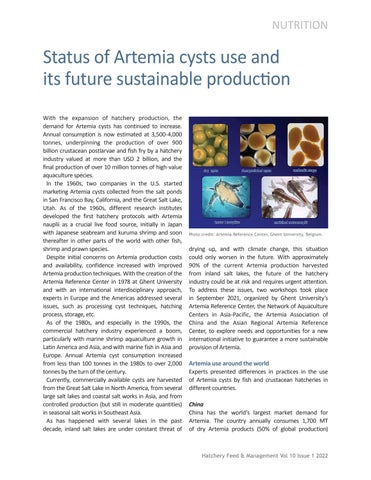NUTRITION
Status of Artemia cysts use and its future sustainable production With the expansion of hatchery production, the demand for Artemia cysts has continued to increase. Annual consumption is now estimated at 3,500-4,000 tonnes, underpinning the production of over 900 billion crustacean postlarvae and fish fry by a hatchery industry valued at more than USD 2 billion, and the final production of over 10 million tonnes of high-value aquaculture species. In the 1960s, two companies in the U.S. started marketing Artemia cysts collected from the salt ponds in San Francisco Bay, California, and the Great Salt Lake, Utah. As of the 1960s, different research institutes developed the first hatchery protocols with Artemia nauplii as a crucial live food source, initially in Japan with Japanese seabream and kuruma shrimp and soon thereafter in other parts of the world with other fish, shrimp and prawn species. Despite initial concerns on Artemia production costs and availability, confidence increased with improved Artemia production techniques. With the creation of the Artemia Reference Center in 1978 at Ghent University and with an international interdisciplinary approach, experts in Europe and the Americas addressed several issues, such as processing cyst techniques, hatching process, storage, etc. As of the 1980s, and especially in the 1990s, the commercial hatchery industry experienced a boom, particularly with marine shrimp aquaculture growth in Latin America and Asia, and with marine fish in Asia and Europe. Annual Artemia cyst consumption increased from less than 100 tonnes in the 1980s to over 2,000 tonnes by the turn of the century. Currently, commercially available cysts are harvested from the Great Salt Lake in North America, from several large salt lakes and coastal salt works in Asia, and from controlled production (but still in moderate quantities) in seasonal salt works in Southeast Asia. As has happened with several lakes in the past decade, inland salt lakes are under constant threat of
Photo credit: Artemia Reference Center, Ghent University, Belgium.
drying up, and with climate change, this situation could only worsen in the future. With approximately 90% of the current Artemia production harvested from inland salt lakes, the future of the hatchery industry could be at risk and requires urgent attention. To address these issues, two workshops took place in September 2021, organized by Ghent University’s Artemia Reference Center, the Network of Aquaculture Centers in Asia-Pacific, the Artemia Association of China and the Asian Regional Artemia Reference Center, to explore needs and opportunities for a new international initiative to guarantee a more sustainable provision of Artemia.
Artemia use around the world Experts presented differences in practices in the use of Artemia cysts by fish and crustacean hatcheries in different countries. China China has the world’s largest market demand for Artemia. The country annually consumes 1,700 MT of dry Artemia products (50% of global production)
Hatchery Feed & Management Vol 10 Issue 1 2022










